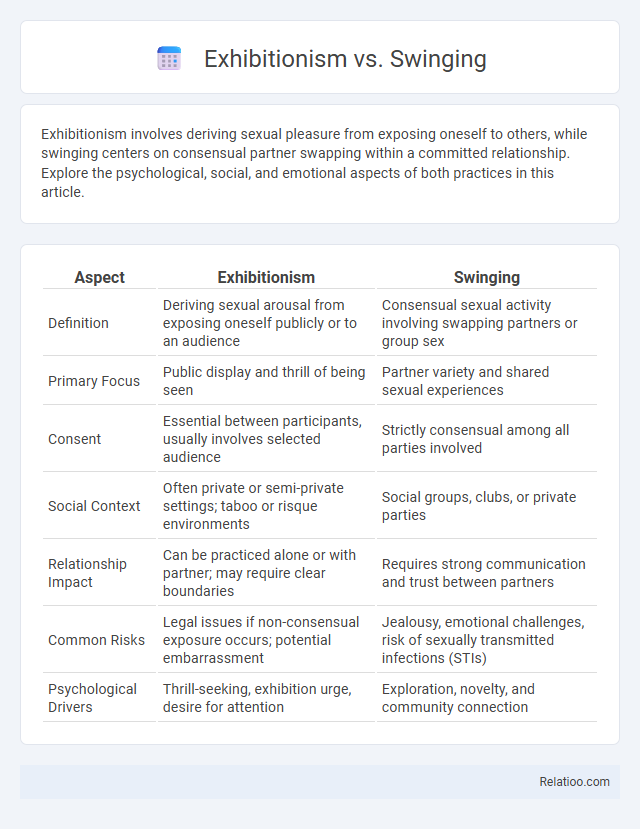Exhibitionism involves deriving sexual pleasure from exposing oneself to others, while swinging centers on consensual partner swapping within a committed relationship. Explore the psychological, social, and emotional aspects of both practices in this article.
Table of Comparison
| Aspect | Exhibitionism | Swinging |
|---|---|---|
| Definition | Deriving sexual arousal from exposing oneself publicly or to an audience | Consensual sexual activity involving swapping partners or group sex |
| Primary Focus | Public display and thrill of being seen | Partner variety and shared sexual experiences |
| Consent | Essential between participants, usually involves selected audience | Strictly consensual among all parties involved |
| Social Context | Often private or semi-private settings; taboo or risque environments | Social groups, clubs, or private parties |
| Relationship Impact | Can be practiced alone or with partner; may require clear boundaries | Requires strong communication and trust between partners |
| Common Risks | Legal issues if non-consensual exposure occurs; potential embarrassment | Jealousy, emotional challenges, risk of sexually transmitted infections (STIs) |
| Psychological Drivers | Thrill-seeking, exhibition urge, desire for attention | Exploration, novelty, and community connection |
Introduction to Exhibitionism and Swinging
Exhibitionism involves deriving sexual excitement from exposing oneself to others without their consent, often linked to psychological factors and legal implications. Swinging, on the other hand, is a consensual lifestyle choice where couples engage in sexual activities with others, emphasizing communication and mutual agreement. Understanding the key differences helps clarify the ethical and social boundaries distinguishing exhibitionism from swinging.
Defining Exhibitionism: Meaning and Motivations
Exhibitionism refers to the psychological behavior where an individual derives excitement or pleasure from exposing their body or sexual acts to an unsuspecting audience, distinct from swinging, which involves consensual partner swapping within a group. Your motivation for exhibitionism often stems from a desire for attention, dominance, or a thrill from breaking social norms, separate from the recreational and mutual consent aspects inherent in swinging. Understanding these differences is crucial in distinguishing authentic exhibitionist tendencies from the lifestyle choices seen in swinging communities.
What is Swinging? Key Concepts and Practices
Swinging refers to the consensual practice where committed couples or individuals engage in sexual activities with others outside their primary relationship, often in social settings or organized events. Key concepts include mutual consent, clear communication, and established boundaries to ensure all participants feel safe and respected. Common practices involve partner swapping, group sex, and attending swinger parties, emphasizing openness and trust among involved parties.
Psychological Drivers Behind Exhibitionism
Exhibitionism involves deriving sexual gratification from exposing oneself to others, driven by psychological factors like the need for attention, dominance, or validation. Swinging, in contrast, focuses on consensual partner exchanges and group sexual activities for novelty and relationship enhancement, with less emphasis on exposure for psychological stimulation. Understanding your motivations for exhibitionism helps differentiate between seeking thrill through public exposure and exploring boundaries within swinging.
The Social Dynamics of Swinging
Swinging involves consensual partner swapping within a community that values trust, open communication, and clear boundaries, creating complex social dynamics centered around mutual respect and shared experiences. Unlike exhibitionism, which focuses on deriving excitement from public exposure, swinging fosters intimate social connections and emotional exchanges between participants. Your active participation in swinging requires navigating these social nuances to build meaningful relationships and maintain ethical interactions.
Consent and Communication in Both Lifestyles
Consent and communication are foundational in both exhibitionism and swinging, ensuring all parties feel respected and safe. In exhibitionism, clear boundaries about where and how exposure is acceptable must be openly discussed to prevent misunderstandings. Swinging requires ongoing dialogue about comfort levels, limits, and emotional check-ins to maintain trust and mutual enjoyment within your relationships.
Legal and Ethical Considerations
Exhibitionism involves exposing oneself in public spaces, often violating laws related to public decency and resulting in severe legal penalties. Swinging, by contrast, is a consensual adult activity that typically occurs in private settings, adhering to ethical standards centered on mutual consent and respect among participants. Legal frameworks generally differentiate these activities based on consent and public exposure, emphasizing personal privacy and community standards to govern ethical behavior.
Stigma and Misconceptions: Dispelling Myths
Exhibitionism, swinging, and voyeurism are distinct expressions of human sexuality often misunderstood due to stigma and misconceptions. Swinging involves consensual partner swapping within a community, whereas exhibitionism typically relates to the urge to expose oneself in public, often linked with psychological motivations, and voyeurism centers on observing others without their awareness. Understanding these differences helps dispel myths and ensures Your exploration of consensual sexual lifestyles is based on respect, consent, and accurate knowledge rather than stigma.
Navigating Boundaries and Safety
Exhibitionism involves deriving pleasure from exposing oneself to others, often in uncontrolled or spontaneous settings, while swinging refers to consensual partner swapping within established boundaries. Navigating boundaries in these practices requires clear communication, mutual consent, and respect for personal and relational limits to ensure emotional and physical safety. Prioritizing consent and safety protocols, such as setting explicit rules and using safe words, reduces risks and fosters trust among participants.
Choosing What’s Right for You: Personal Exploration
Exploring the nuances between exhibitionism and swinging requires understanding your own comfort levels and boundaries within consensual adult activities. Exhibitionism involves deriving excitement from exposing oneself to others, while swinging centers on partner-based consensual non-monogamy, often in private or social settings. Personal exploration involves honest self-reflection and clear communication with partners to align experiences with your desires and emotional safety.

Infographic: Exhibitionism vs Swinging
 relatioo.com
relatioo.com